Human Flower Project
Kiku Ningyo—Bodies in Bloom
The craft of making chrysanthemum dolls, an imperial entertainment and art of the Edo period, is dwindling, but one town north of Tokyo soldiers brightly on.
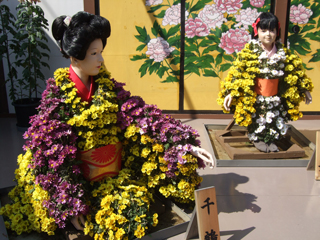
A tableau of chrysanthemum dolls in the annual kiku show of Nihonmatsu, Japan; mythological figures or Japan’s version of Donna Reed?
Photo: Human Flower Project
We don’t go in for “bucket lists,” really, but having learned about Japan’s chrysanthemum fairs several years ago from Masashi Yamaguchi and seeing pictures of Hirakata’s astounding life-sized chrysanthemum dolls, we certainly have dreamed.
Perhaps Buckminster Fuller did too – the blooming ozukuri, a living prototype for his geodesic domes.
This fall we woke up from that dream in Nihonmatsu, Japan. Botanical gardens in many Japanese cities continue to hold fall chrysanthemum shows, but very few have sustained the esoteric art of making kiku ningyo (chrysanthemum figures/dolls). Nihonmatsu’s exhibition is the biggest and perhaps the last.
A small city, about 2 ½ hours north of Tokyo by train, Nihonmatsu lies on the edge of the Abukuma Mountains. To the west, Mt. Adatara rises over an extant volcano, the thermal waters percolating up to many onsen (hot springs) in the vicinity of Dake. (Please consult—or initiate—the Human Bathing Project on this!)
Nihonmatsu has held a chrysanthemum fair annually since 1930. In recent years it’s been staged at the castle on the northern edge of town, quite a spread and very well suited to this astonishing imperial art form. (A samurai warrior in a cape of purple buds, daisies sprouting on his chest, deserves a promontory to gaze from.)
The event opened October 1 and would run all the way through November – chrysanthemum prime time. Fortunate as we were to see this spectacle at all, unfortunately we could be there only in the show’s first week. There were plenty of mannequins and lots of greenery but not too many blooms. The ozukuri had barely begun with a few white sparks of open petals, not much trace of the visual fireworks ahead.
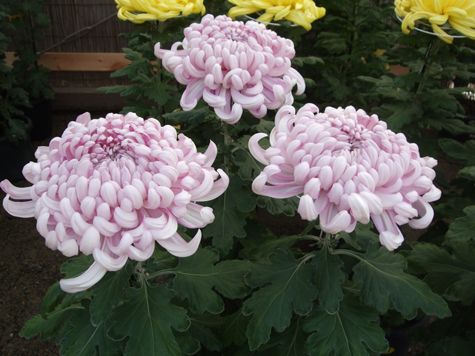
Ogiku – one variety of chrysanthemum—in bloom Oct. 5, 2010, at Nihonmatsu Castle
Photo: Human Flower Project
There were a few spectacular ogiku in bloom and some of the “dolls” were in full flower, too. But the time to be there would have been about a month later, especially since Japan had a very long, warm summer, delaying the chrysanthemums’ flowering by, we heard, two weeks.
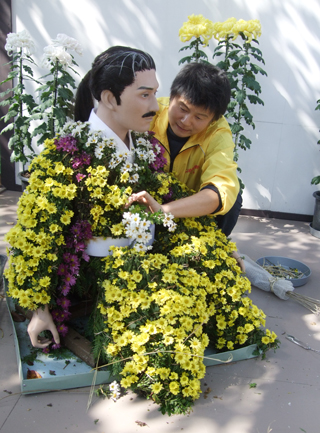 Hideaki Tsuji, a kiku master from Yokohama, worked on one of the dolls. He’s practiced this botanical craft for 20 years.
Hideaki Tsuji, a kiku master from Yokohama, worked on one of the dolls. He’s practiced this botanical craft for 20 years.
Photo: Bill Bishop
We did have the good luck to meet a kiku master at work. Hideaki Tsuji was busy poking small mums into the sternum of a kneeling figure who looked a bit like Kevin Kline. He’d wrapped the plants in wet sponge moss. Then, using a long piece of heavy wire as a needle and tatami grass as thread, he stitched flowers into the figure one by one.
Hideaki, from Yokohama, said he’d worked at this craft for 20 years, having learned it from his father. He said there used to be many big shows of kiku ningyo all over the country but now, even in Tokyo, the chrysanthemum fairs typically will include only one or two floral figures. (The famous Hirakata chrysanthemum doll show was last held in 2006.)
Most of the dolls were presented in groups, in scenes. For two very ignorant visitors from Austin, Texas, the tableaux were all completely inscrutable. Who were those men in the prow of a ship? With swords strapped to their floral sides, clearly many of the “dolls” were warriors. Others, on their knees—with shaved heads and faraway gazes – seemed priestly, if a mannequin can be priestly. Were the mother and child mythological? Historical? Or were they just jolly “everyday people” covered with chrysanthemum implants? We don’t know.
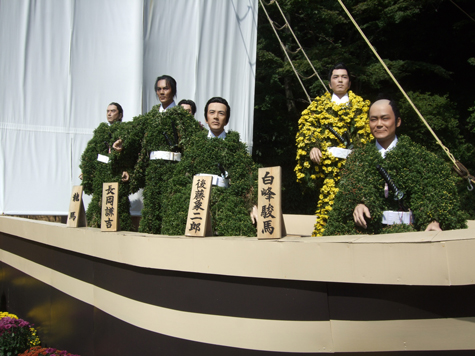
A tableau of chrysanthemum doll sailors. Explanation, anyone?
Photo: Bill Bishop
Near the end of our tour through the exhibits, we came upon a building where some kind of performance was evidently soon to begin. As we sat in folding chairs with about two dozen other visitors, a sound track started, piping out music and a narrative (in Japanese). On barely visible rails and cords, life sized chrysanthemum dolls came rolling out from the wings and descending from above. We were treated to 10 such scenes, with changing backdrops and squeaky entrances and exits of these amazing flowering figures.
Something seemed to be happening in a cave, then a woman (?) with blond hair snarled over her face appeared to be menacing some young men. At about Scene 7 we saw what we had never thought to dream of wanting to witness: two amply dressed mannequins loaded up with blooming chrysanthemums copulating. Abjuring all the spoken and unspoken rules of Japanese courtesy (innumerable) we shot from our seat to bring you this very bad photograph.

A provocative scene from Ousyusekigahara, a Japanese folk tale, enacted with chrysanthemum dolls in Nihonmatsu, Japan.
Photo: Human Flower Project
After returning to Austin, we corresponded with our new friend Minori Goto in Kyoto, pleading for help. What was this? We had also sent Minori a photo of the poster outside the theatre.
“This Chinese character represents 奥州安達ヶ原(Ousyusekigahara), one of the titles of Kabuki. Do you know Kabuki?” Minori wrote. Not really, but we do know that it’s a very stylized art of dance, costumes, and drama, based on traditional tales – stories drawn from folklore, kind of like our own Brothers Grimm.
“This story of kabuki is so fearful,” Minori wrote. “The main character in this drama is a hag,” and she referred us to this site for more, asking, “Was it beautiful or weird?”
We’d say it was so far beyond weird as to make beauty moot.
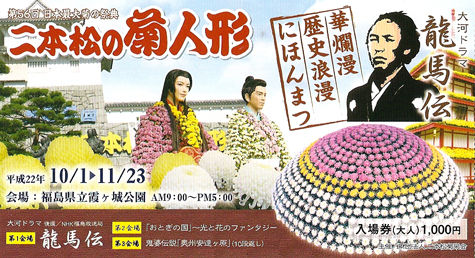
Some time in the future we’d hope to return to Nihonmatsu in mid-November, when the ozukuri, in full flower, look ready to lift into outer space and all the men on the ship have blossomed, and to visit Yokohama to continue our interview with Hideaki when he has time to spare, and to attend a kabuki performance. That’s why we don’t go in for “bucket lists.” Our bucket’s got a hole in it.
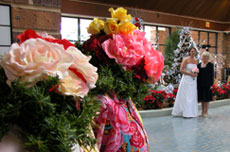

The legend of the hag is quite intimidating!